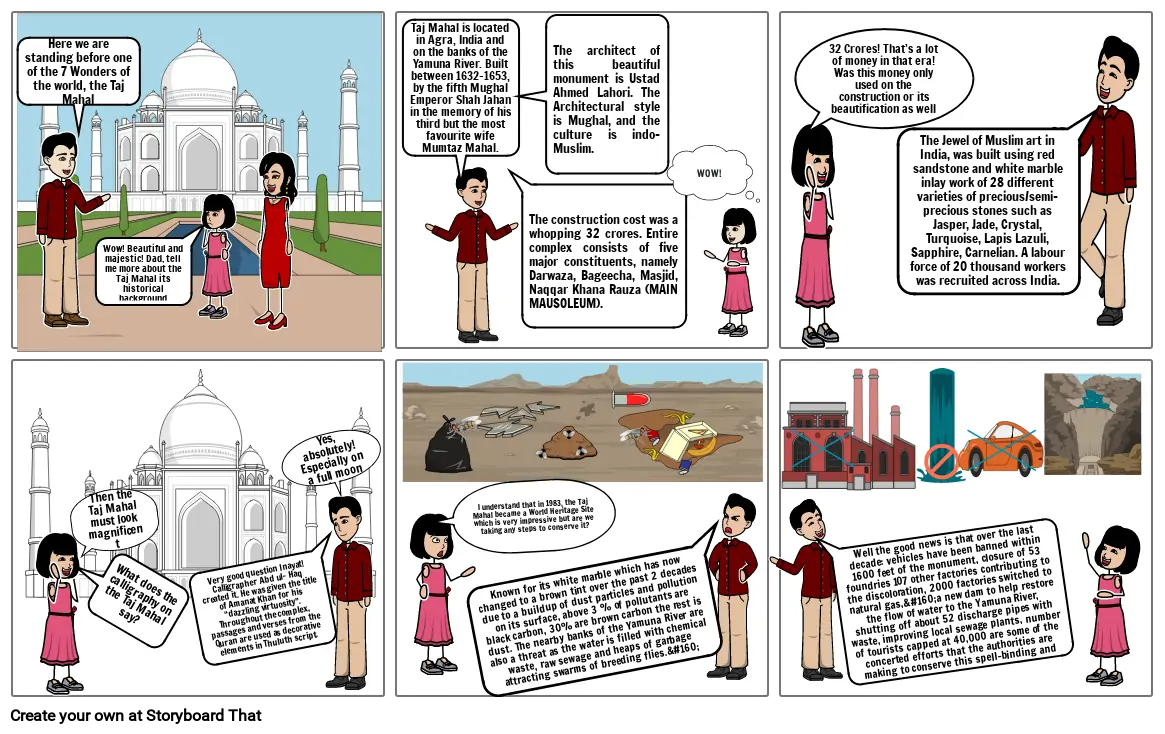Taj Mahal

स्टोरीबोर्ड पाठ
- Here we are standing before one of the 7 Wonders of the world, the Taj Mahal
- Wow! Beautiful and majestic! Dad, tell me more about the Taj Mahal its historical background
- Taj Mahal is located in Agra, India and on the banks of the Yamuna River. Built between 1632-1653, by the fifth Mughal Emperor Shah Jahan in the memory of his third but the most favourite wife Mumtaz Mahal.
- The construction cost was a whopping 32 crores. Entire complex consists of five major constituents, namely Darwaza, Bageecha, Masjid, Naqqar Khana Rauza (MAIN MAUSOLEUM).
- The architect of this beautiful monument is Ustad Ahmed Lahori. The Architectural style is Mughal, and the culture is indo-Muslim.
- WOW!
- 32 Crores! That’s a lot of money in that era! Was this money only used on the construction or its beautification as well
- The Jewel of Muslim art in India, was built using red sandstone and white marble inlay work of 28 different varieties of precious/semi-precious stones such as Jasper, Jade, Crystal, Turquoise, Lapis Lazuli, Sapphire, Carnelian. A labour force of 20 thousand workers was recruited across India.
- What does the calligraphy on the Taj Mahal say?
- Then the Taj Mahal must look magnificent
- Very good question Inayat! Calligrapher Abd ul- Haq created it. He was given the title of Amanat Khan for his “dazzling virtuosity”. Throughout the complex, passages and verses from the Quran are used as decorative elements in Thuluth script.
- Yes, absolutely! Especially on a full moon night!
- I understand that in 1983, the Taj Mahal became a World Heritage Site which is very impressive but are we taking any steps to conserve it?
- Known for its white marble which has now changed to a brown tint over the past 2 decades due to a buildup of dust particles and pollution on its surface, above 3 % of pollutants are black carbon, 30% are brown carbon the rest is dust. The nearby banks of the Yamuna River are also a threat as the water is filled with chemical waste, raw sewage and heaps of garbage attracting swarms of breeding flies.
- Well the good news is that over the last decade: vehicles have been banned within 1600 feet of the monument, closure of 53 foundries 107 other factories contributing to the discoloration, 2000 factories switched to natural gas,a new dam to help restore the flow of water to the Yamuna River, shutting off about 52 discharge pipes with waste, improving local sewage plants, number of tourists capped at 40,000 are some of the concerted efforts that the authorities are making to conserve this spell-binding and picturesque wonder!
30 मिलियन से अधिक स्टोरीबोर्ड बनाए गए

